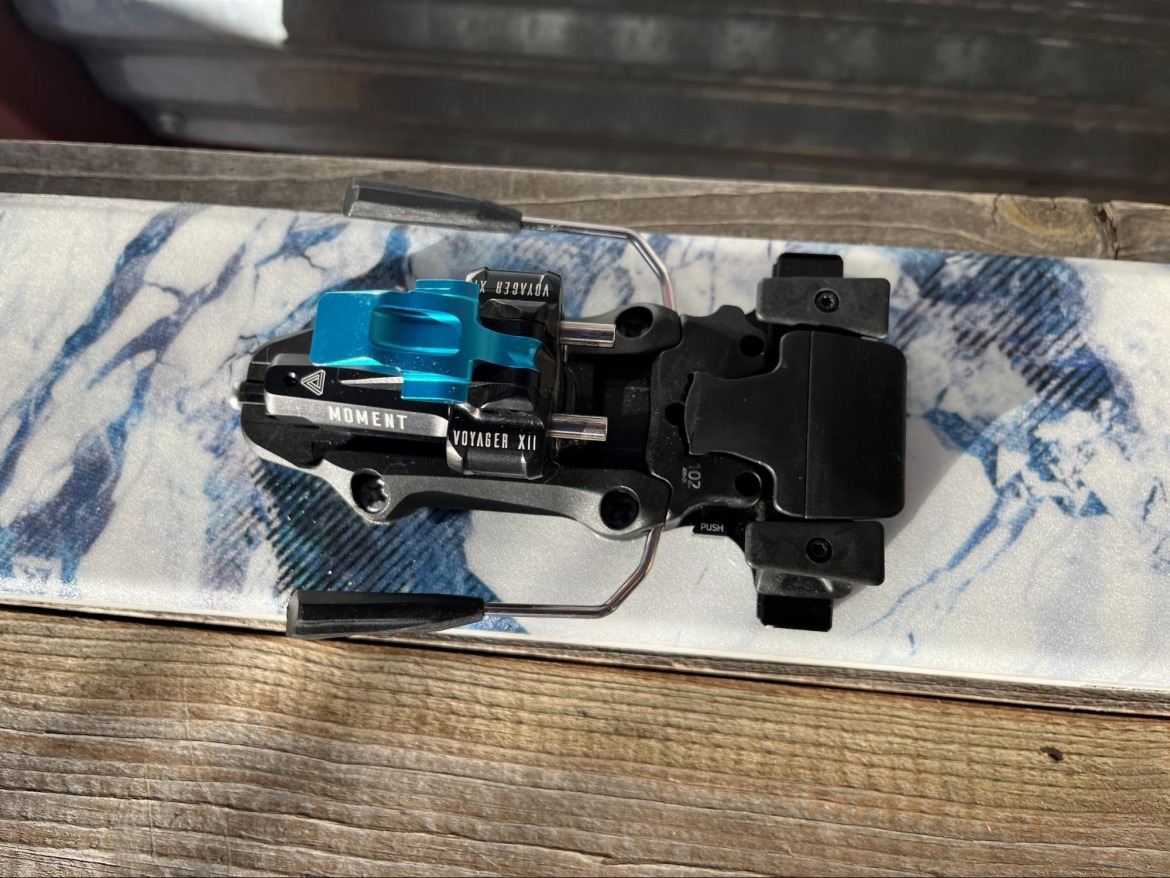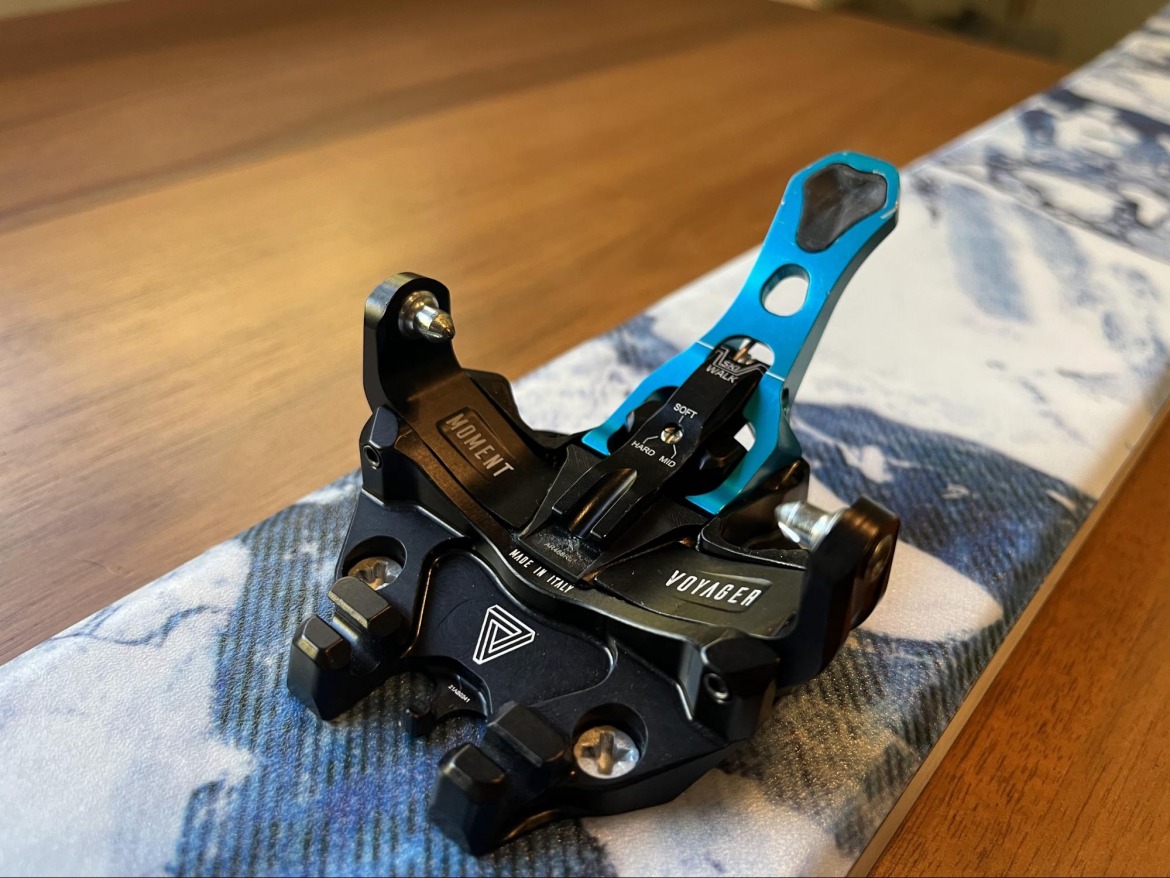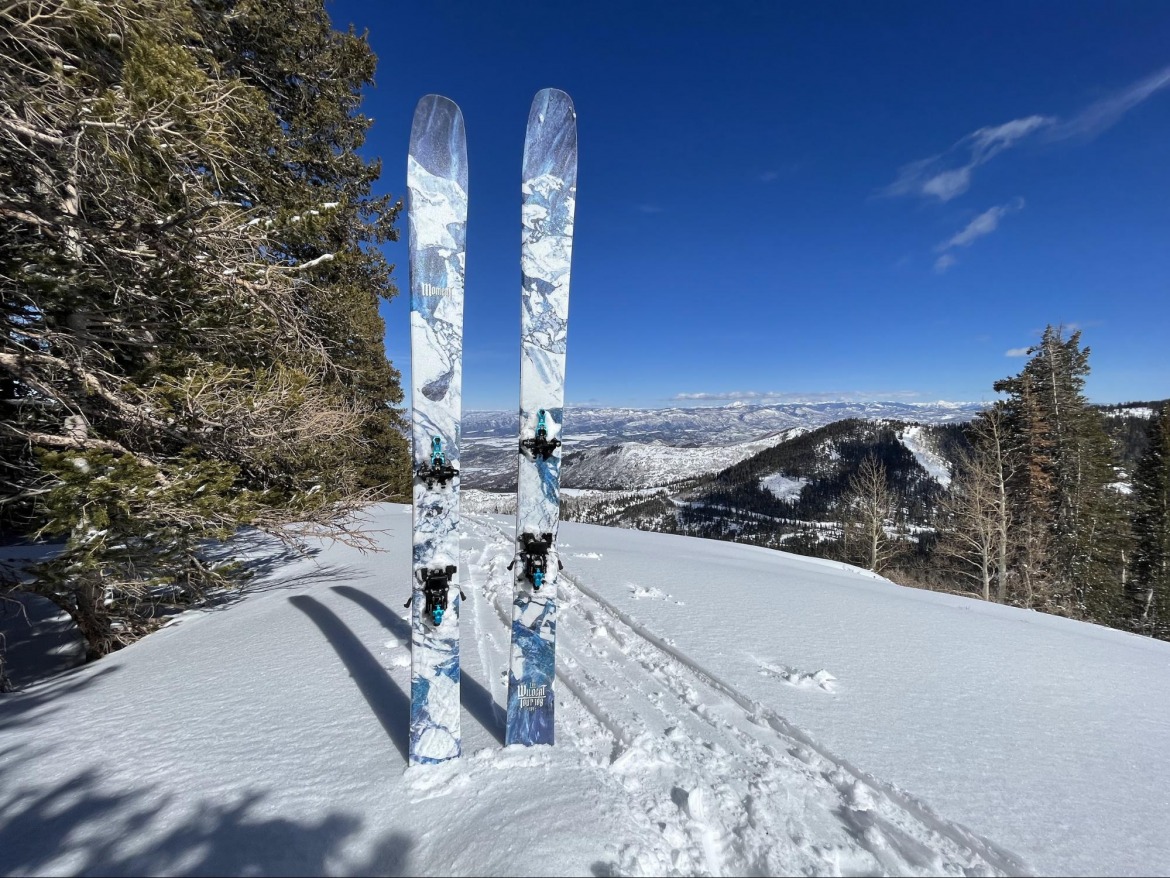
The Moment Wildcat Tour 108 entered my life at the time as I began to acknowledge the limits of wide powder skis and tech bindings as I embraced skiing conditions other than prime powder. Being swayed by the merits of big skis in soft snow limited me to the most prime conditions of mid-winter storms, and I had finally come to cast a longing eye at sub 110mm skis: The Wildcat Tour 108 smudged that out.
Moment is located in Reno, Nevada, at the foothills of the Sierra on Bible Way. Which, when you consider the biblical devotion of some Moment evangelists, is an apt street for the ski maker. (We’ll have more on Moment as a ski maker in a different story.) For now, we’ll genuflect towards a specific ski-binding pairing, the Wildcat Tour 108 and the Voyager X II binding.
Comparing Wildcat Tours to Fish
The Moment Wildcat Tour 108 entered my life at the time as I began to acknowledge the limits of wide powder skis and tech bindings as I embraced skiing conditions other than prime powder. Being swayed by the merits of big skis in soft snow limited me to the most prime conditions of mid-winter storms, and I had finally come to cast a longing eye at sub 110mm skis.
Before the Wildcat Tours, my primary ski touring setup had been Line Pescado skis with Dynafit Speed Radical bindings. The glorious flotation of this setup has been prime for exploring low-angle meadows and trees, with enough nimbleness to negotiate gullies choked with brush and deadfall. (The Pescado are wide, 125mm underfoot, have a swallowtail, and aren’t exactly light, pushing 2000g.) I’ve come to admire the basic functionalism of the Speed Radical bindings, but the shortcomings of being suspended on pins and wires become apparent when trying to push wide skis aggressively in hard-packed / steeper conditions. .
The Wildcat Tour 108 skis & Voyager bindings have opened up a wider realm of exploration with predictable confidence that feels more distinctly like a complimentary package of ski & binding than any other combination I’ve skied. The skis have a remarkable line-holding tenacity while retaining enough maneuverability to keep a distinctly playful/jibby characteristic. For an extra 45 grams, the Voyager bindings provide a significantly improved skiing experience over the Speed Radicals while retaining much of the simple elegance of the tech binding system.
Voyager XII Bindings
The Binding Stats:
Release range: Vertical and horizontal 5-12
Claimed weight: 385g with brakes and hardware
Heel/toe drop: 7mm
Elastic travel: 12mm
Riser options: 4+ a flat mode
Adjustment range: 25mm
Freeride spacer: Yup
Price $699.00
Lou has already provided a fantastic in-depth look at the technical features of the ATK Freeraider, which is the same basic platform as the Voyager.
Returning to brakes after several years of only running leashes was illustrative of how many habits I had developed around the assumption that my skis were always attached to my boots. On one of my first days at the resort with the ski, I forgot the importance of releasing the push-to-lock brake feature, and dropped the ski on the snow to clip in, only to watch it race away to the parking lot. Later, I engaged in more bad habits by not locking the toe lever in tour mode on what I anticipated to be a mellow climb, and of course, popped out of the toe on a surprise steep section; my ski slid away. Luckily, one of my tour partners was just downhill to catch it. Ruminating on these incidents, I think I will add a leash to the bindings this year for extra back up against such incidents.
Voyager II Technical Notes
Toe Springs: The toe springs utilize a flat spring instead of coils. I was delighted to find this dramatically reduced snow/ice build-up under the toe piece, forgoing one element of the “DyaFiddle” ritual of requiring popping the toe piece open and shut several times to clear build-up, and ensure a clean engagement. The Voyager bindings never required this extra level of attention, always snapping shut with firmness and precision. I haven’t had occasion to use the “Uphill Hardness Variator.” Still, I appreciate having the adjustability to accommodate the inevitable differences that can occur between various boot / binding interfaces, both through manufacturing tolerances and wear patterns.
The five climbing modes are a bit overkill; I found the three settings achievable from the regular touring mode sufficient without resorting to rotating the heel to achieve the other two intermediate positions. The forward side of the heel post is still prone to snow build-up when touring without risers, whereas utilizing one of the low riser positions will prevent compaction.
Freeride Spacer / Stance: Much of the distinctive ride characteristics of the Voyager binding are due to the flatter geometry of the “Freeride Stance,” 7mm drop from heel to toe, augmented by the Freeride Spacer that provides contact with the heel of the boot, providing a much more positive platform of contact with the ski rather than simply being suspended on pins. This platform provides significantly more control in choppy snow and steeper terrain. Even at intermediate-pace skiing, the benefits of having full heel contact with the ski rather is a dramatic difference. Aiding this stable composure is the 12mm of elastic travel in the heel, which significantly s the ride feel from the “coaster brake clunking down the mountain” sensation of traditional tech bindings. After skiing the Voyager binding, I can’t help but think of the Speed Radical bindings on my Pescados being a significant factor in the limitations I have experienced in variable conditions.
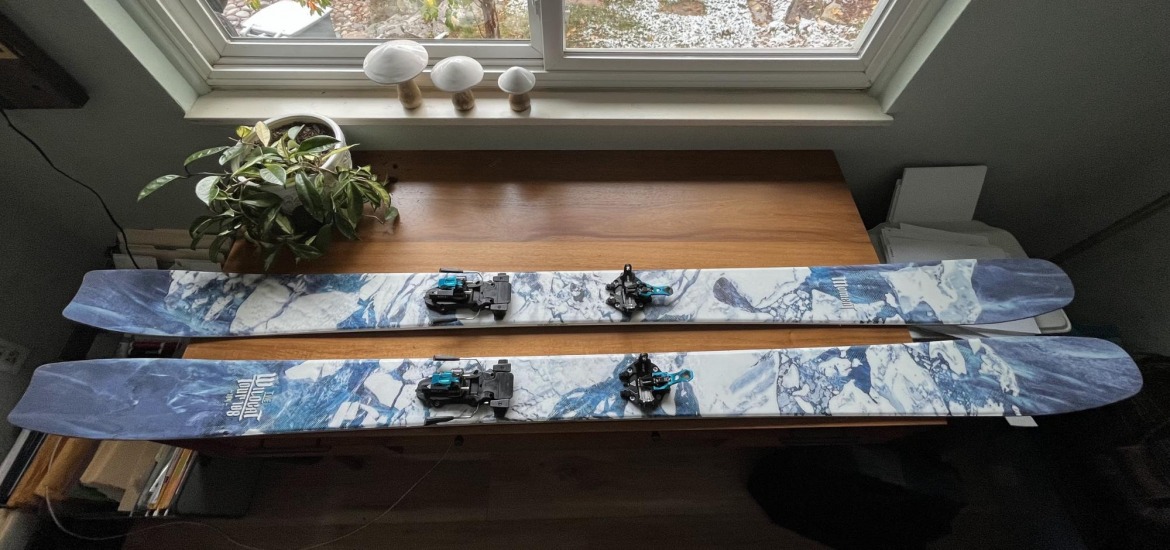
Eye candy for any passerby: the Wildcat Tour 108 has ~5mm of camber underfoot and plenty of tip and tail rocker.
Wildcat Tour 108
The Ski Stats:
Weight: 2162 / 2147 grams per ski mounted with Voyager binding
Length: 184cm
Dimensions mm: 134 / 108 /127
Radius: 22 m
Effective Edge: 1500mm
Core: Paulownia / Ash
Layup: “a combination of lighter triaxial and carbon fiber.”
Sidewall: Full ABS
Price: $849.00

This image from Moment illustrates the Wildcat Tour 108’s mustache rocker.
The Moment Wildcat Tour 108 traces a storied heritage based on the Moment Bibby / Blister Pro, a cult classic in-bounds ski that inspired the aphorism “playful charger” on the review site of the same name. The distinctive characteristics of this ski are the Moustache Rocker profile: a generous tip, and tail rise, and approximately 5mm of camber underfoot.
The squared-off tip and tail sections are the visual signatures of all Moment skis. When Casey Hawkinson built his first set of skis, they were with standard rounded tips. Local ski “experts” razzed him, “Oh, you just painted K2 skis Blister Pro black.” So he took a grinder to his freshly pressed skis and created the signature squared-off profile. The Tour’s tips are a bit more rounded to interface better with skin hardware, and the tails have a shallow scallop to secure a tailhook.
The Wildcat Tours required a bit of adjustment after two seasons on the ultra wide-shoveled, fish-tailed Pescado. The Pescado reminds me of bikes built around the short chainstay concept that love to pivot direction and be ridden off the back wheel. The Wildcat Tour feels more like my high-pivot / long wheelbase Dreadnought in that it rewards holding a centered stance and a committed line choice. Only in limited instances did I miss the ultra-floaty characteristics of the Pescado; low-angle, slow-speed bushwhacking, and the deepest & fluffiest of days.
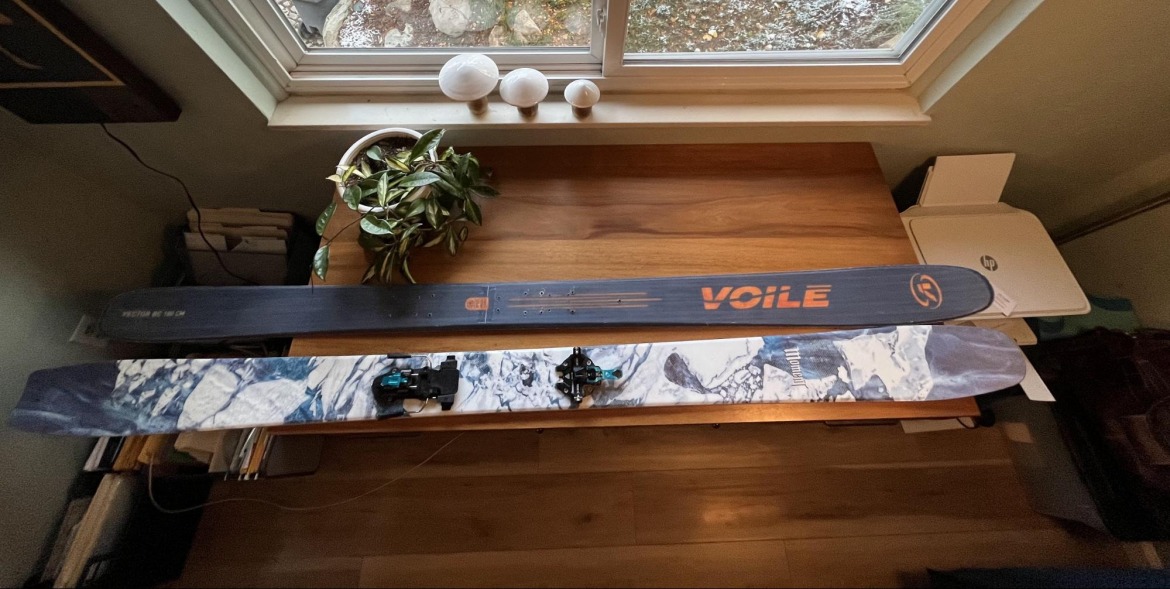
Caption : The tip rise and mid-camber profile of the Wildcat Tour reflects similar design cues to the Voile Vector, with the highly splayed tail being the most significant departure from the Vector’s relatively flat tail. The second-hand Voile Vector BC’s are on deck for more tele-tech / fish scale experimentation. All of my time on the Vectors has been on tele gear, but the flatter tails do seem to encourage “finishing,” or “following through” on turns, whereas the turned-up tails on the Wildcat Tour allow for quicker slashing and pivoting.
The predictability of the Wildcat Tour won me over, knowing that if I held a good stance, and looked ahead, it would pull me through. Like the Rossignol Soul 7 helped me progress from a beginner to intermediate level, the Wildcat Tours encouraged me to progress my skiing to a more aggressive level. More so than the Soul 7, the Wildcat Tour requires a certain amount of confidence and commitment to ski well. It rewarded this confidence by being a predictable companion in a wider range of conditions than any other ski I’ve tested. Particularly when encountering the firmer, more chopped-up snow conditions of in-bounds skiing, the Wildcat Tour, combined with the binding’s elasticity, flatter stance, and full heel contact, allowed for more aggressive, harder-charging skiing than the previous ski with traditional tech bindings.
I’m still figuring out the mechanics of getting airborne on skis; most of my “hang time” consists of small boulder drops or the occasional powder puff pillow line. Even with my limited skills, the Wildcat Tours exhibit a poppiness that encourages seeking side hits. Despite the turned-up tails, I never found them lacking for back-seat support if I landed awkwardly, emphasizing how well-balanced this ski feels, always encouraging a centered-to-forward stance.
One of the primary drawbacks to touring on big skis (no matter the weight) is that if you are using them in optimum conditions (soft snow), there is no escaping the fact that you are soon pushing a barge load of snow uphill on top of those wide ol’ planks. The black top sheets of the Pescado inevitably freeze and crust over, making for an extra-tacky surface for snow to adhere to. The white and blue glacial colors of the ’21 Wildcat Tour were notably better at shedding snow and presented less surface area for collecting snow.
In my experience, the flotation advantages a wide ski provides in breaking trail uphill are soon negated by the extra snow load that inevitably accumulates. The reduced snow load on the lighter-colored and narrower Wildcat Tour 108s made them a clear winner when multiple laps or longer days were the objective.
On firmer, more variable snow conditions, the Wildcat Tour holds true to its namesake, possessing both line-holding tenacity, and sure-footed maneuverability. Combined with its touring efficiency, the sure-footedness of the Wildcat Tour in less than prime conditions made exploring without expectations much more appealing. The Mustache rocker profile of generous camber underfoot, combined with significant tip & tail rocker, and VDS foil incorporated into the layup contribute to the uniquely balanced characteristics that make for such a well-poised ski.
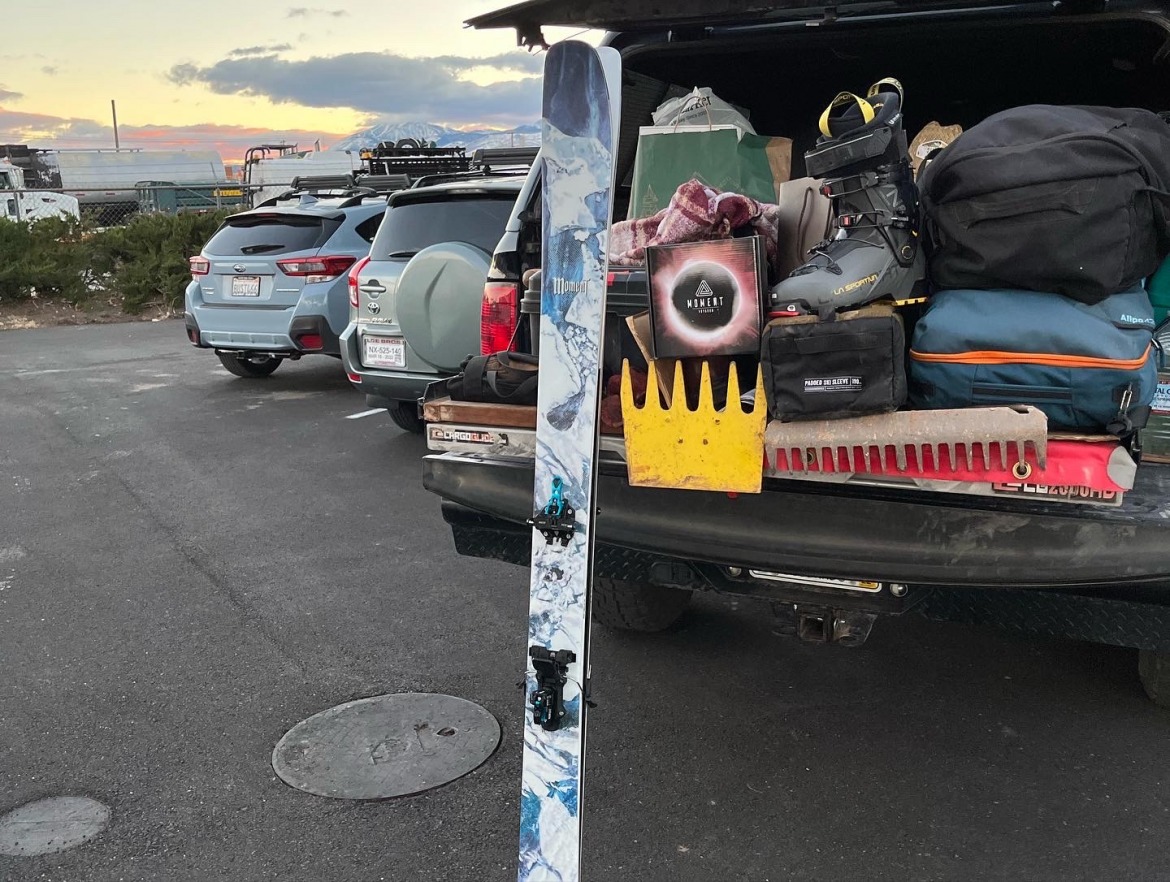
Picking up the Movement Wildcat 108s in Reno on Bible Way.
My most memorable run on the Wildcat Tour was on late-season, well-settled snow, exploring some “interesting” routes off the local xc ski loop. A pronounced drainage cleft exhibited nearly the full spectrum of low-elevation skiing; towering dark spruce littered with deadfall on the north slope, on the opposite south slope, open meadows interspersed with pockets of dense brush. In the upper bowl, there was plenty of room to zig-zag between the two elements. The sunny side had crusted into the glazed ice that has you suddenly rocketing forward over uncertain rollers towards unmade decisions of how to avoid the fast-approaching wicket of whippy brush. In the shade of the spruce, the snow held softer and more predictable, but random blockades of deadfall limited line selection, forcing me to dance between the two conditions. Falling to the road below, the cadence of the dance between crust and thicket, powder and deadfall, increased, and the windows between the two extremes shrank as I descended further into the commitment of having to ski the line out.
I paused in the last opening and stared down into the choked abyss to pick my line. Which snaggy skeletal limb to pivot around? I spied a sliver of a gap in the brush where I could duck my head, raise my poles, and charge through in my best bull elk impersonation, to pivot on the icy opening and head back for the tangled powder. Beyond that, there was no telling what lay ahead, other than there would be no more opportunity to hesitate or second-guess — only seeing the line and skiing it. The Wildcat Tours bounded through the thicket, crust, and downed trees as if they were born to it; slashing, pivoting, floating, and sure enough, I found myself landing on my feet at the bottom of the run, purring with contentment.
The Voyager Binding and Wildcat Tour 108 ski complement one another as an integrated package more so than any other ski and binding combination I have tried. Usually, it seems that one element outperforms the other or is limited from achieving its full performance by the design limitations of the other. If you are focused on earning your turns and want predictable performance in the variable conditions of both wild snow and loved-to-death resort snow, the Wildcat Tour 108 ski and Voyager XII binding would make an excellent quiver-of-one choice.
Aaron Mattix grew up in Kansas and wrote a report on snowboarding in seventh grade. His first time to attempt snowboarding was in 2012, and soon switched over to skis for backcountry exploration near his home in Rifle, CO. From snow covered alleys to steeps and low angle meadows, he loves it all. In the summer, he owns and operates Gumption Trail Works, building mountain bike singletrack and the occasional sweet jump.

